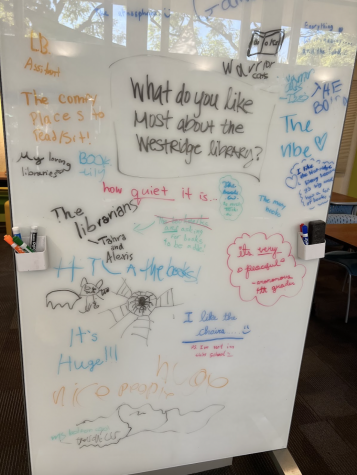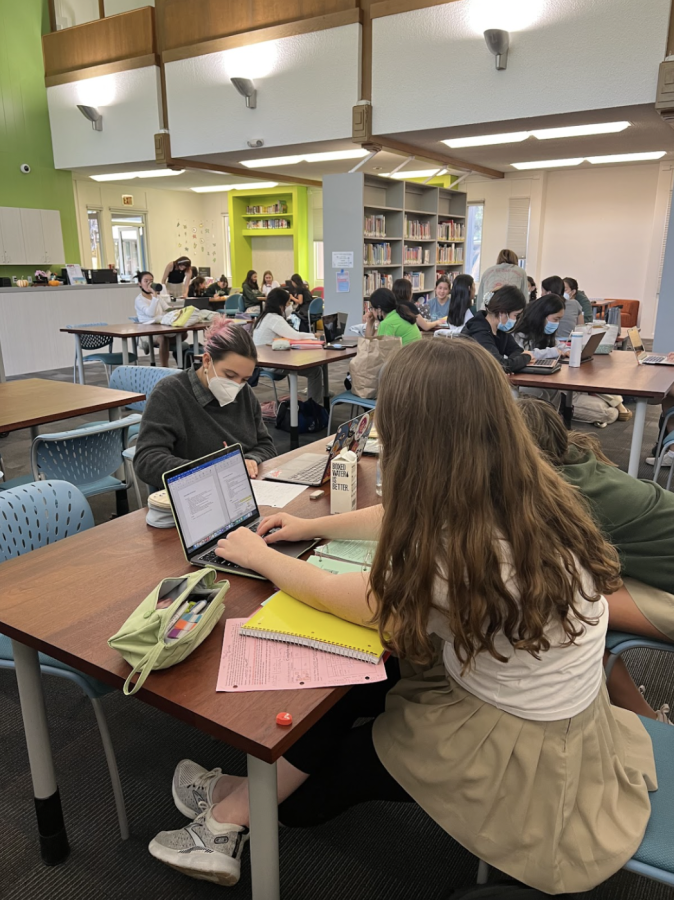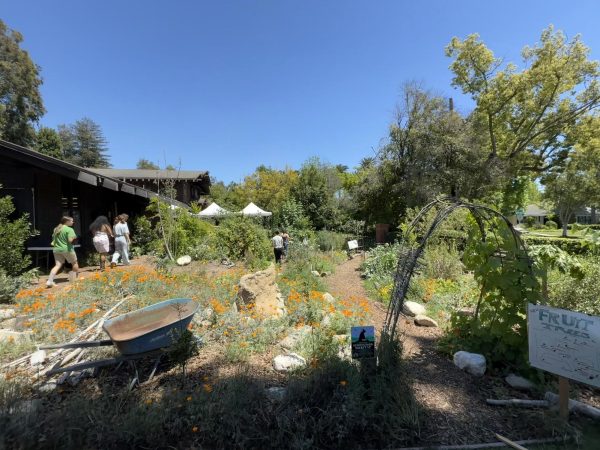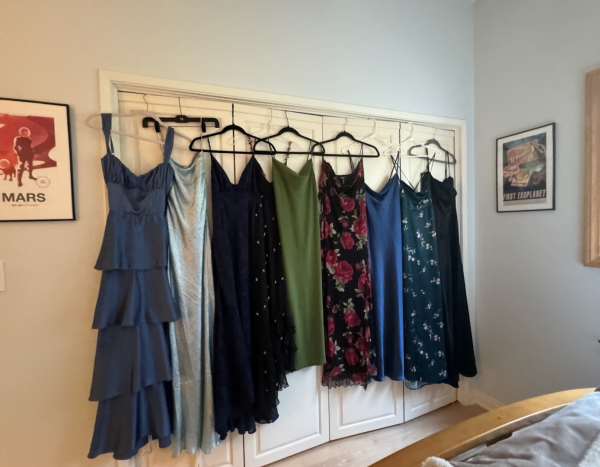The Westridge Library Lacks a Noise Policy: What Does This Mean for Students?
Some students work in the library as others collaborate with their peers.
When she has the opportunity to visit the Westridge library during the school day, Anoush J. ’30 enjoys chatting with her friends about the book she is reading. The inviting environment as a result of the collaboration welcomed in the library excites Anoush. Anoush explained, “I’m okay with reading with noise, partly because I kind of create the noise with my friends. Because it’s fun to talk about what you’re reading.” Anoush noted, “We’ve gotten less warnings [for making noise] this year.”
While a handful of students appreciate how the library provides them with a space to socialize, other students find the high noise levels to be distracting from the schoolwork they hope to complete during their time in the library.
The Westridge Library currently does not have a noise policy that designates it as a quiet space.
Stephanie Bolton, Westridge’s Librarian, explained how the library adopted a policy a few years ago that classified certain periods during the day as “quiet time.” However, students had difficulty following the policy. Ms. Stephanie explained, “I think it was hard for students to keep in mind, ‘sometimes I can have a conversation in this space and sometimes I can’t.’ I think that sort of flip was difficult.”
Additionally, creating quiet environments during certain times of the day became challenging to enforce. when students were collaborating or working on group projects: “It just became…me continually going over them and having to ‘shush’ them.”
Ms. Stephanie explained that noise levels in the library fluctuate depending on the time of the day and who’s using the library. The library tends to be the noisiest before the school day starts, but noise levels typically decrease at 8:40, when Upper school classes begin. Likewise, when Lower schoolers have their breaks, the library’s noise levels increase again.
“I try to sort of go with the vibe, as it were, so like, let’s say there’s like five or six upper schoolers in here that are quietly studying, and lower schoolers come in here and are…at a higher volume. I would have a conversation like, ‘Hey, this is a shared space, like “let’s be respectful,”’” Ms. Stephanie said.
Some students are distracted from their schoolwork as a result of the library’s absence of a noise-regulating policy. Conversations among students can disturb students who are seeking a quiet place to study and focus.
Lindsay B. ’25 said, “A library is a place where you’re meant to quietly read your book or quietly do your homework…There’s just so many people [in the library] and they’re all having different conversations that are really loud.”
She continued, “Sometimes I just want to study and focus on my homework. And I expect the library to be that place where I can do that. However, like lately, it’s just not been the place for quiet time to focus.”

Echoing Lindsay’s sentiment, Lauren K. ’24 said, “Not having a noise policy has affected the way I study because it makes me want to do certain types of homework [at the library]. For example, I can’t read in noise. So I generally don’t bring my books into the library…But when I do read on campus, I do have to go somewhere else.”
Neighboring schools such as Flintridge Preparatory School have “dual-spaced” libraries that offer separate spaces for those wishing to work silently, as well as those wanting to collaborate and converse with others. The lower library level of Flintridge Preparatory School’s Chandramohan Library “is open for collaborative work and catching up with friends,” with the upper level “offer[ing] a quiet and comfortable study space.”
While Ms. Stephanie explained that she wants to help serve as many students as possible, the limited space of the library is a challenge. She said, “The school library I was at before this one was a dual-spaced library. So we had a downstairs space and upstairs space. And it was really easy to have downstairs for group work and talking, and then upstairs for quiet study time.”
Although Christina S. ’24 finds distracting noise frustrating in the library when she has a pressing assignment due, she also recognizes how noise positively impacts the library’s approachable atmosphere: “I also think that sometimes it being loud in here makes it a little less intimidating, like the atmosphere is a little less intimidating.”
Similarly, Ms. Stephanie commented on how library spaces have evolved from quiet study spaces to community centers and places where people come together. She explained, “I like this idea that the library can serve the whole student [body], not just the student that needs to sit down and study, but also the student that needs a break and to talk to friends and to play games and to do coloring sheets.”

Sophene is a senior and in her sixth year on Spyglass. In her free time, she enjoys baking, spending time with family, and watching Gilmore Girls and Friends.

















![Dr. Zanita Kelly, Director of Lower and Middle School, pictured above, and the rest of Westridge Administration were instrumental to providing Westridge faculty and staff the support they needed after the Eaton fire. "[Teachers] are part of the community," said Dr. Kelly. "Just like our families and students."](https://westridgespyglass.org/wp-content/uploads/2025/03/dr.-kellyyy-1-e1748143600809.png)
















































